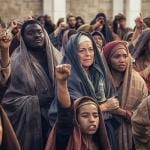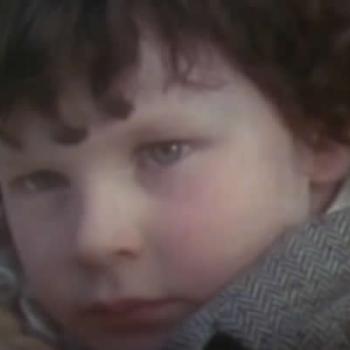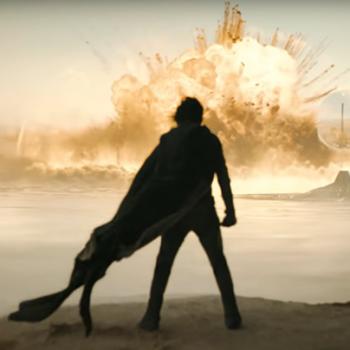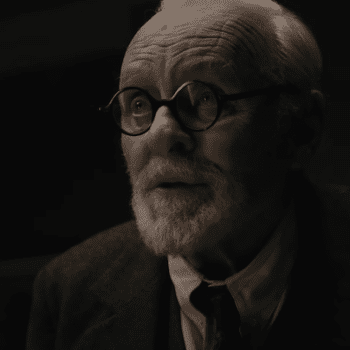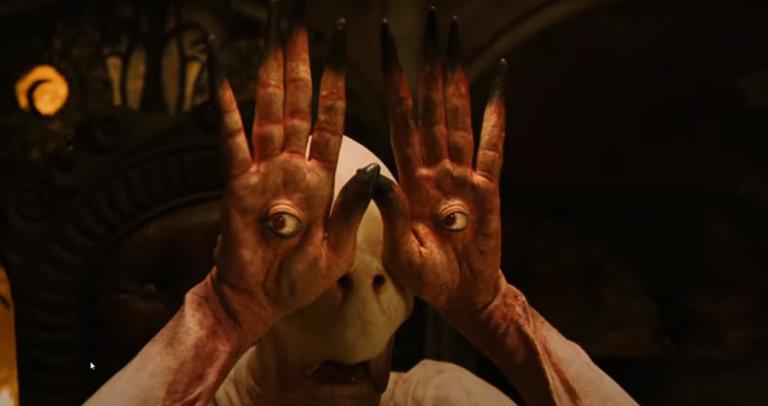
Pan’s Labyrinth is not, exactly, a horror movie—no matter what my podcast partner might say. Guillermo del Toro’s freaky fable is more like a dark fantasy tale spliced together with, admittedly, an all-too-horrifically real war drama. So to post this on Halloween week feels a little like cheating.
But the film includes many elements that’d be right at home in supernatural horror movies: monsters, magic and some surprisingly deep reflections on the nature of evil. It’s also deeply interested in faith and religion. What does Labyrinth say about them? Well, that seems to depend on who’s watching.
Much of the story takes place in a wooded corner of fascist Spain. A quiet mill has become a military outpost, commanded by the sadistic Captain Vidal (played by Sergi Lopez). The Catholic Church, it seems, has sided with the Captain and fascism (as it did, of course, in real life): A priest is one of the Captain’s dinner guests early in the movie, and when one guest balks at the Captain’s suggestion that each nearby family should get just one ration card, the priest says they’ll be just fine. “God has already saved their souls,” he insists. “What happens to their bodies hardly matters to Him.”
Later, the Captain’s own troops offer a perverted nod to the Lord’s Prayer: “This is our daily bread in Franco’s Spain!” one soldier shouts at the people waiting in line for food, adding that the government will supply every Spaniard’s needs. The meaning is clear: Sure, the Church still has a role in fascist Spain—but only to glorify the country’s real god: Franco.
That above-ground reality is horrifically mirrored, in a way, down below. For as Captain Vidal works to augment his power and destroy the rebels in the nearby hills, his stepdaughter, Ofelia (Ivana Baquero), is dealing with her own problems.
Ofelia’s mother recently married the Captain and is pregnant with the Captain’s baby. The Captain insisted on bringing his wife and Ofelia to the mill, despite the fact that the pregnancy is not going particularly well. Soon after she and Ofelia arrive, the 10-year-old girl discovers an ancient stone maze that leads to a stone stairway. She goes down and meets a Faun, who tells her that she’s secretly a princess! But to reclaim her long-vacant throne, she’ll need to undergo three terrifying tasks.
The second task is probably the movie’s most memorable: Ofelia’s encounter with the Pale Man. That scene, too, takes the shape of a feast, and it plays heavy with a spiritual, Catholic flavor. The Pale Man’s lair feels a lot like a church, what with its pillars and arches and even the half-dome above the Pale Man himself—a naked, flabby creature whose eyes sit on a plate. Pictures of the Pale Man surround the room, depicting him killing and eating children. In substance, they’re horrific. But in style, they feel like illustrations one might find in a Medieval Bible, or even a chronicle that blasphemously mirrors the Stations of the Cross.
Del Toro’s views on what the Pale Man represents have expanded over time. But in an interview with Twitch Film in 2006, he said, “The Pale Man represents the Church for me, y’know? Represents fascism and the Church eating the children when they have a perversely abundant banquet in front of them.”
Certainly through the first part of the film, Del Toro positions the Catholic Church as an adversary, both in his realistic and fantastic worlds. A pagan ethos—represented by Del Toro’s faun and fairies and in some ways culminating with a magic spell involving a mandrake root, milk and blood—seems to offer the film’s hope of salvation.
But that’s not entirely accurate. Indeed, the story takes a twist, with layers that perhaps even Del Toro didn’t fully anticipate. Writing for The Guardian, Del Toro says:
I … have a fear of reason and dogma; it gives me the shivers. But maybe my upbringing keeps getting in the way. When I showed Pan’s Labyrinth to my friend Alejandro González Iñárritu [director of The Revenant], he said: “That’s a truly Catholic film.” And there was me thinking that it was a truly profane film, a layman’s riff on Catholic dogma. It’s true what they say: once a Catholic, always a Catholic.
We’re diving into spoiler territory, so be warned.
During the funeral of the Captain’s wife, who dies during childbirth, the movie’s Catholicism takes a quick turn—moving away from corrupt institutionalism to something more ethereal and honest. The priest offers a powerful, enigmatic psalm that embraces the mystery of faith itself:
Because the paths to the Lord are inscrutable; because the essence of His forgiveness lies in His word and in His mystery; because although God sends us the message, it is our task to decipher it. Because when we open our arms, the earth takes in only a hollow and senseless shell. Far away now is the soul in its eternal glory, because it is in pain that we find the meaning of life, and the state of grace that we lose when we are born; because God, in His infinite wisdom, puts the solution in our hands; and because it is only in His physical absence that the place He occupies in our souls is reaffirmed.
I love that last line: “Only in His physical absence that the place He occupies in our souls is reaffirmed.”
The funeral presages Pan’s Labyrinth’s last difficult act.
Ofelia fails a portion of her test with the Pale Man, and the faun initially casts her out: She’s not the princess, he tells her. She will live and die in this horrible, above-ground world of hers. Later, the faun seems to have a change of heart—but he warns Ofelia that she must obey him—follow his orders without question.
And then he demands that Ofelia give her brother to him for sacrifice. “Just a drop of blood,” the faun reassures her. “A pinprick, that’s all.” But she, and we, don’t believe him.
The faun asks if she’s willing to sacrifice her throne, her rights, for a “brat you barely know.” A brat, incidentally, that indirectly caused the death of Ofelia’s mother. He asks if this little baby, who’s caused her such pain and humiliation, is worth it. Ofelia says that he is: She will sacrifice whatever she has to to protect this infant.
“As you wish, your highness,” the faun says.
And with those words, Captain Vidal—who snuck stealthily behind Ofelia—shoots her.
Ofelia is hardly a perfect Christ figure. For one thing, the child is wholly innocent. Jesus died for the guilty, and we are more like Captain Vidal than we’d like to admit. But Ofelia gives up a kingdom to save someone who’s done nothing to earn her favor; she bleeds and dies for him, in fact—and in her sacrifice, she finds herself snatched up into the movie’s definition of glory, earning crowns in an underground heaven.
In Captain Vidal’s view of the world, sacrificing the weaker for good of the strong would make perfect sense. It is, in fact, the way the real world sometimes works. But Ofelia was operating not in the world’s power, but in something stronger, subtler, gentler. The whole scene reminded me of “the deep magic” we hear about in C.S. Lewis’ The Lion, The Witch and the Wardrobe—the magic that required a horrible sacrifice to rescue a guilty child. Underneath that magic, we learn, is a deeper magic still.
Pan’s Labyrinth is saturated in magic—the magic found in dark fairy tales and druidic circles. But underneath that magic is a deeper magic: One built on mercy and grace and losing one’s life for another. In that deeper magic, death is not the end. What is lost will be found again.



